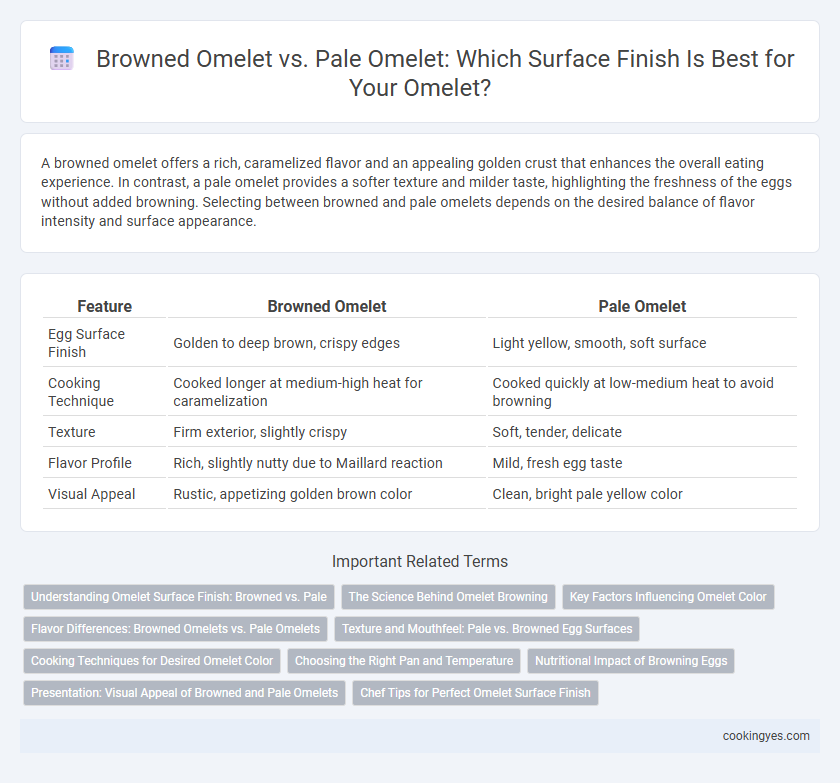A browned omelet offers a rich, caramelized flavor and an appealing golden crust that enhances the overall eating experience. In contrast, a pale omelet provides a softer texture and milder taste, highlighting the freshness of the eggs without added browning. Selecting between browned and pale omelets depends on the desired balance of flavor intensity and surface appearance.
Table of Comparison
| Feature | Browned Omelet | Pale Omelet |
|---|---|---|
| Egg Surface Finish | Golden to deep brown, crispy edges | Light yellow, smooth, soft surface |
| Cooking Technique | Cooked longer at medium-high heat for caramelization | Cooked quickly at low-medium heat to avoid browning |
| Texture | Firm exterior, slightly crispy | Soft, tender, delicate |
| Flavor Profile | Rich, slightly nutty due to Maillard reaction | Mild, fresh egg taste |
| Visual Appeal | Rustic, appetizing golden brown color | Clean, bright pale yellow color |
Understanding Omelet Surface Finish: Browned vs. Pale
A browned omelet surface finish results from higher heat cooking, creating Maillard reaction compounds that enhance flavor and provide a slightly crispy texture. A pale omelet, cooked at lower heat, retains more moisture, yielding a tender, soft surface but with a milder taste. Understanding these differences helps in choosing the desired texture and flavor profile for various culinary applications.
The Science Behind Omelet Browning
The browning of an omelet results from the Maillard reaction, a chemical process between amino acids and reducing sugars in eggs when exposed to heat above 140degC (284degF). A browned omelet surface indicates higher heat exposure, enhancing flavor complexity and a slightly crispy texture, while a pale omelet signifies lower heat, preserving a softer, milder taste with less Maillard-induced flavor compounds. Controlling cooking temperature and time is essential for achieving the desired egg surface finish that balances texture and flavor.
Key Factors Influencing Omelet Color
Omelet color is primarily influenced by cooking temperature, time, and the composition of the egg mixture, with higher heat producing a browned surface due to the Maillard reaction. Protein content and added ingredients such as dairy or vegetables can affect browning by altering moisture levels and pH balance. Controlling these key factors ensures a desired surface finish, ranging from a pale, tender omelet to a richly browned and flavorful exterior.
Flavor Differences: Browned Omelets vs. Pale Omelets
Browned omelets develop a caramelized surface through the Maillard reaction, enhancing their flavor with rich, nutty, and slightly sweet notes. Pale omelets retain a softer texture and milder taste, emphasizing the natural egg flavor without the toasty complexity. The choice between browned and pale omelets directly influences the overall flavor profile, with browned omelets offering deeper, more robust flavors compared to the delicate, subtle taste of pale omelets.
Texture and Mouthfeel: Pale vs. Browned Egg Surfaces
A browned omelet surface develops a slightly crispy texture that adds a satisfying contrast to the tender interior, enhancing the overall mouthfeel with subtle caramelized notes. In contrast, a pale omelet surface maintains a soft, uniform texture that emphasizes creaminess and a delicate bite, preferred for smoother consistency. Choosing between browned and pale surfaces influences the sensory experience significantly, from softness to the complexity of flavors.
Cooking Techniques for Desired Omelet Color
Browned omelets develop a caramelized surface through cooking at medium-high heat, which enhances flavor via the Maillard reaction and creates a slightly crispy texture. Pale omelets require gentle, low-heat cooking that preserves a tender, smooth surface with a softer mouthfeel and a more delicate appearance. Adjusting heat levels and cooking time allows precise control over the Maillard reaction intensity and moisture retention, producing either a browned or pale omelet finish.
Choosing the Right Pan and Temperature
Selecting a non-stick or well-seasoned cast iron pan ensures even heat distribution essential for achieving the perfect browned omelet. Cooking over medium-high heat allows the egg surface to develop a golden, caramelized finish without burning, while lower temperatures result in a pale, moist texture. Controlling pan temperature is critical; too hot causes rapid browning and potential burning, whereas too low prevents surface color development, affecting both appearance and flavor.
Nutritional Impact of Browning Eggs
Browned omelets develop a Maillard reaction that slightly alters the egg's protein structure and flavor profile, while pale omelets retain more of the egg's original nutrients such as biotin and certain amino acids. High heat used to achieve browning can reduce heat-sensitive vitamins like vitamin B12 and folate but can increase antioxidant availability through Maillard reaction products. Balancing cooking time and temperature helps preserve the maximum nutritional value while enhancing the omelet's texture and flavor.
Presentation: Visual Appeal of Browned and Pale Omelets
Browned omelets showcase a rich, golden-brown surface that enhances visual appeal through a caramelized texture, attracting the eye with its appetizing contrast and depth. Pale omelets offer a soft, uniform creamy yellow finish that appeals to those seeking a delicate and smooth presentation. The choice between browned and pale omelets significantly influences the overall plating aesthetics, impacting diners' perception of flavor and freshness.
Chef Tips for Perfect Omelet Surface Finish
Achieving the ideal browned omelet surface requires precise heat control and timing, maintaining medium-low heat to develop a golden crust without burning, while avoiding high heat that results in uneven browning or pale spots. Using a non-stick pan and evenly beating eggs promotes a smooth surface finish with consistent texture. For a pale omelet, slightly lower temperatures and gentle stirring help preserve a tender, delicate appearance preferred in French-style omelets.
Browned omelet vs Pale omelet for egg surface finish Infographic

 cookingyes.com
cookingyes.com